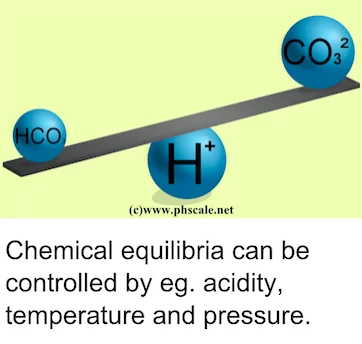pKa and Ka


Background information
The Kavalue is a value used to describe the tendency of compounds or ions to dissociate. The Kavalue is also called the dissociationconstant, the ionisation constant, and the acid constant.
| Topic:Equilibriums | The pH scale |
The pKavalue is related to the Kavalue in a logic way. pKavalues are easier to remember than Kavalues andpKavalues are in many cases easier to use than Kavalues for fast approximations of concentrations of compounds and ions inequilibriums.
Definition of pKaand Ka
The definition of Kais: [H+].[B] / [HB], where B is the conjugate base of the acid HB.
The pKavalue is defined from Ka, and can be calculated from the Kavalue from the equation pKa =-Log10(Ka)
| Topic:Ideal Gas Law | Ionic Strength |
Example on how pKaand Kavalues are used
An example of ammonium and ammonia and how Kaand pKavalues are used is given below. The Ka value of NH4+is5.75.10-10under ideal conditions at 25 degrees Celsius.
This Kavalue is used to determine how much of the NH4+is dissociated into its conjugate base NH3by thereaction NH4+=> NH3+ H+.
Do also notice that the reaction NH4+NH3+ H+can go either way, depending on conditions.
By introducing the parameter TAN (Total Ammonium Nitrogen) which is ([NH4+] + [NH3]) it can be calculated how much of theTAN is on the form NH4+and NH3at any given pH.
The calculations allowing this is a bit complicated, but when you have been through them once, it is really simple:
TAN = [NH4+] + [NH3] = [NH3].(1+[NH4+] / [NH3])
Notice that normal rules such as multiplication before addition applies.
By removing the second part of the above equation only:
| Topic:pKa& Ka | The basics |
TAN = [NH3].(1+[NH4+] / [NH3])
remains. This equation can be rearranged to:
[NH3] = TAN / (1+[NH4+] / [NH3])
By multiplying the denominator in the last part of the above equation with [H+] one gets:
[NH3] = TAN / (1+[H+].[NH4+] / [NH3].[H+])(*)
The definition of Ka said that Ka = [H+].[B] / [HB]. Written in the context of the above example, Ka of ammonium orNH4+is: [H+].[NH3] / [NH4+]. This is not enough for a smooth substitutionin (*) so we calculate 1 / Ka to [NH4+] / [H+].[NH3]
which can be substituted into(*):
[NH3] = TAN / (1+([H+].[NH4+] / [NH3].)[H+])[NH3] = TAN / (1+ [H+] / Ka)(#)
From this equation [NH3] can be calculated when TAN, [H+] and Ka are known.
Let’s say that TAN is 0.1 M, pH is 8.24 and the Kavalue is 5.75.10-10, equivalent of a pKavalue of 9.24.If weplace these values into (#) we get that:
[NH3] = 0.1 / (1 + 5.75.10-9/ 5.75.10-10) or 0.1/11 = 0.009 M
The trick with using pKa values is, that in equilibriums like the ammonium/ammonia equilibrium you can always tellthat if the pH value is 1 unit lowerthan the pKavalue, the concentration of ammonia [NH3] is 1/11 of the total TAN concentration because of the base 10 log relationshipbetween Kaand pKa. Had the pH value been 7.24, or 2 units less than the pKa value, 1/101 of the TAN had been [NH3].
With a little experience one can give rough estimates of ions and compounds in equilibrium without a calculator just by looking at the pKavalueand the type of equilibrium.
Recent Posts
How do I create an engaging and informative online quiz or assessment?
Creating an engaging and informative online quiz or assessment can be a powerful tool for… Read More
What are the most effective methods for managing and reducing work-related stress in the hospitality industry?
Work-related stress is a common issue in the hospitality industry, where employees often face long… Read More
How can I improve my assertiveness and communication skills in a leadership position?
In a leadership position, assertiveness and effective communication skills are crucial for success. Being able… Read More
What are the key elements of a successful employee recognition and rewards program?
Employee recognition and rewards programs play a crucial role in motivating and engaging employees, as… Read More
How do I effectively manage and respond to customer feedback and reviews?
Customer feedback and online reviews play a crucial role in shaping a company's reputation and… Read More
What are the best strategies for effective time management as a stay-at-home parent?
Effective time management is crucial for stay-at-home parents who juggle multiple responsibilities on a daily… Read More